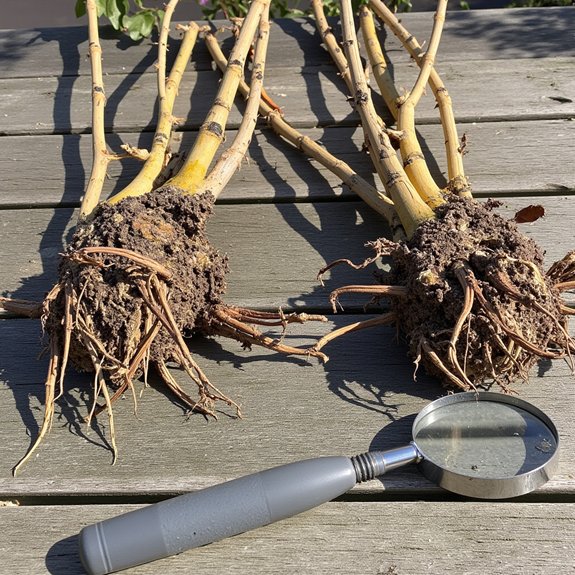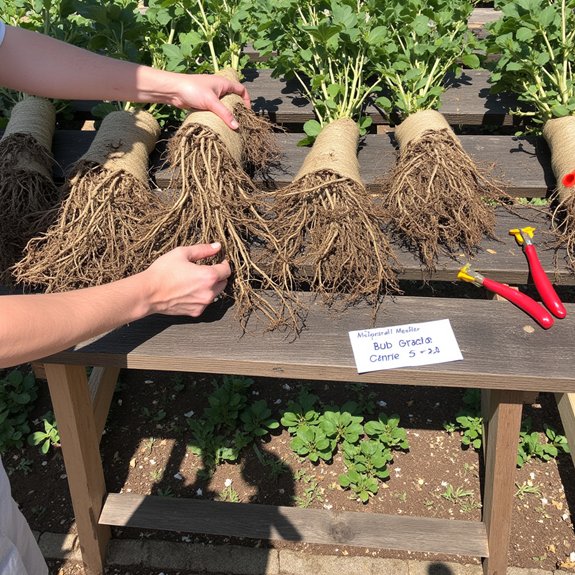It’s no coincidence that many gardeners discover bare root roses just when they’re looking to expand their garden on a budget. You’ll find these dormant, soil-free plants offer savings of 30-50% compared to potted varieties, but there’s more beneath the surface than simple economics. While bare root roses can transform your garden into a thriving showcase, choosing the wrong source or ignoring quality indicators could turn your bargain into a costly mistake.
Contents
What Are Bare Root Roses and How Do They Work?

Dormancy defines the essence of bare root roses, which arrive at garden centers as sleeping beauties wrapped in protective packaging. These 1-3 year old plants come without soil, nestled in wood shavings and often coated with protective wax. You’ll find them available from late winter through early spring, before their potted counterparts hit the shelves. Their compact design makes shipping easier and storage simpler. When you’re ready to wake them up, proper planting techniques become essential for success. Different rose varieties respond uniquely to bare root conditions, so you’ll want to research your specific cultivar’s needs before breaking ground.
The Cost-Effective Benefits of Choosing Bare Root Over Potted
While potted roses might catch your eye with their immediate blooms, bare root varieties deliver considerably better value for your gardening budget. You’ll typically save 30-50% compared to potted plants, allowing you to expand your garden without breaking the bank. Smart purchasing strategies include buying multiple plants at once for volume discounts and shopping early-season sales. The compact packaging reduces shipping costs, which retailers often pass along as savings. You can also invest those cost savings into quality soil amendments and fertilizers, ultimately creating a healthier foundation for your roses to thrive long-term.

Despite the initial savings, bare root roses often carry hidden risks that can quickly erode their cost advantage. Labeling issues plague many bare root purchases, leaving you uncertain about the actual variety you’re planting. Without initial blooms to verify identity, you might discover you’ve purchased the wrong rose months later.
Transport damage frequently occurs during shipping, compromising root systems and canes. Poor storage conditions at big box stores worsen these problems. Additionally, bare root roses commonly harbor diseases like mosaic virus, which are nearly impossible to detect before purchase, potentially infecting your entire garden.
Disease Risks and Industry Challenges You Should Know
Beyond the visible damage you might spot during inspection, bare root roses carry invisible threats that can devastate your garden for years. Mosaic virus and bile hide silently, spreading through your collection before symptoms appear. Big box stores worsen disease transmission by housing infected plants together, creating breeding grounds for bacteria and pests.
This widespread problem hurts industry sustainability too. When diseased roses fail, gardeners view them as disposable annuals rather than decades-long investments. The cycle continues as disappointed buyers abandon rose gardening entirely, shrinking the market and reducing quality standards across suppliers.
Smart Shopping Tips for Healthy Bare Root Rose Success

Three simple strategies can dramatically improve your chances of getting healthy bare root roses that’ll thrive for decades. First, shop at local nurseries instead of big box stores, where staff expertise and plant quality are typically superior. Second, inspect each plant carefully before buying, checking for firm, plump canes without black spots, soft areas, or obvious damage. Look for healthy, white root systems rather than dried, brittle ones. Third, time your shopping strategically by purchasing early in the season when selections are freshest. These healthy selections and smart shopping strategies will set you up for rose garden success from day one.
